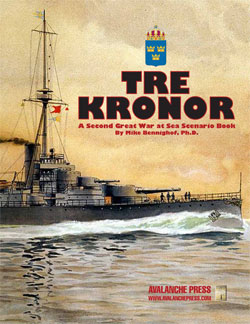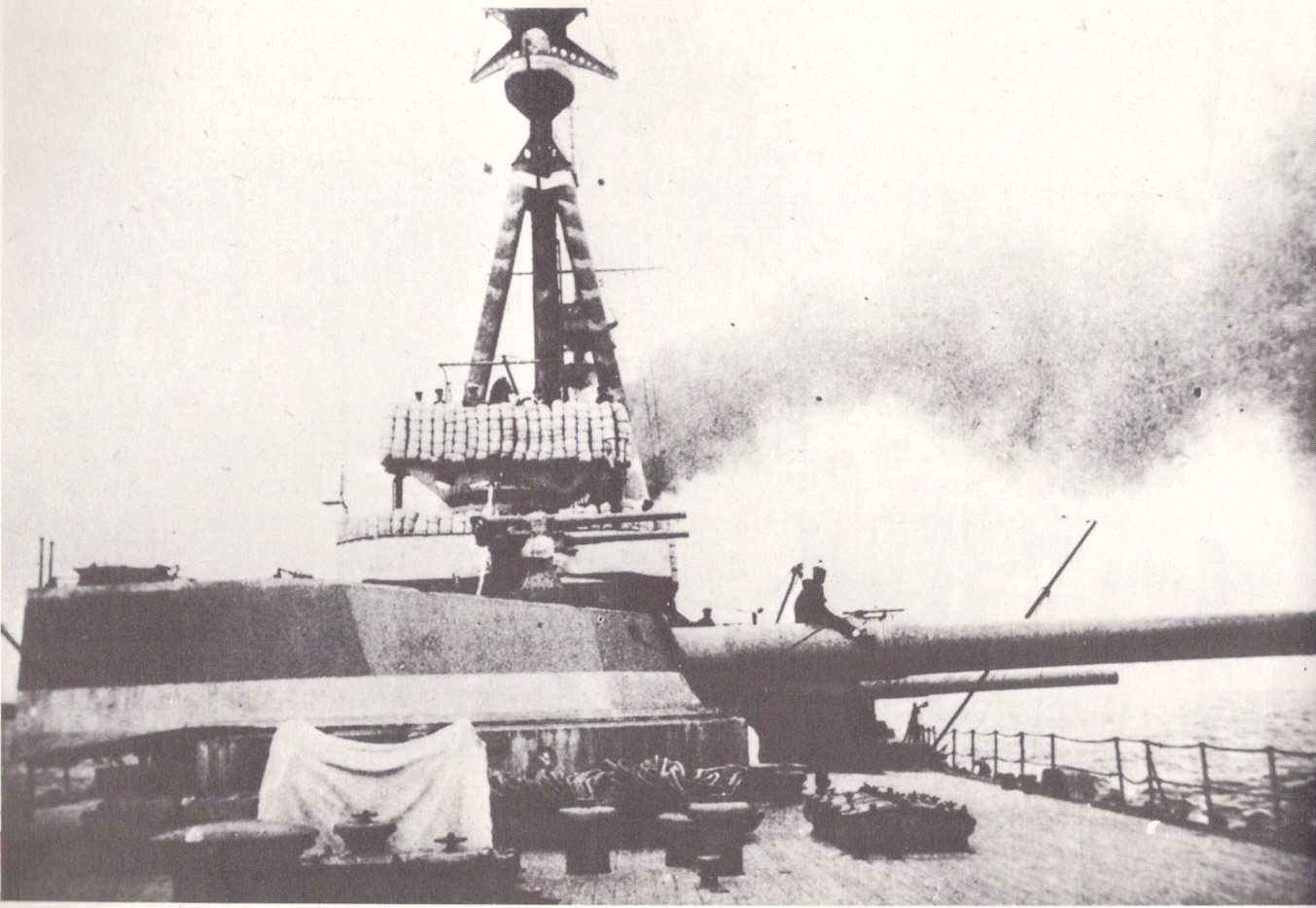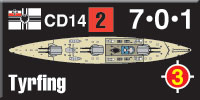Tre Kronor:
German Coast Defense Ships, Part Two
by Mike Bennighof, Ph.D.
April 2023
 Arms control power politics in the world of the Second Great War make the coast-defense ship an attractive option for a number of nations’ navies. In our own history, the limits on such ships (2,000 tons, six-inch guns, no armor and a maximum speed of 21 knots) meant that few fleets took advantage of the clause. That’s not the case in our Second Great War setting, where the limits allow much larger ships and place a cap on battleship construction. Arms control power politics in the world of the Second Great War make the coast-defense ship an attractive option for a number of nations’ navies. In our own history, the limits on such ships (2,000 tons, six-inch guns, no armor and a maximum speed of 21 knots) meant that few fleets took advantage of the clause. That’s not the case in our Second Great War setting, where the limits allow much larger ships and place a cap on battleship construction.
With both Russia and France obviously arming for war, many in Germany’s Admiralstab and in the Reichstag urged the Kaiser and his Navy chief, Grand Admiral Johannes Hartog, to ignore the naval limitations agreement and lay down at least six new battleships at once. The civilian government’s Socialist leaders, backed by Wilhelm II, refused to make Germany the aggressor. Hartog suggested a new class of coast defense ships built to the new treaty limits, and modernization of one Great War-era coast defense ship and six older dreadnoughts that had lain in reserve for over a decade. The Socialist deputies – always ready, as Hartog knew, to funnel work to their fanatic backers working in shipyards and steel mills – agreed to fund this more reasonable request.
The old coast-defense ship had been laid down before the Great War at the Vulkan shipyard in Stettin, intended for the Royal Hellenic Navy. As a coast-defense ship, she displaced 13,000 tons and carried an armament of six American-made 14-inch guns in three twin turrets: one forward, one aft and one amidships. The Greeks rejected her when it became known that their Turkish rivals had purchased the Brazilian dreadnought Rio de Janeiro, and they insisted that the design be re-cast as a full-fledged dreadnought. The new design had eight 14-inch guns, but looked very similar to the original ship. That ship, the dreadnought, would be completed after the war and delivered to Greece.

The big guns of Njörd.
Construction had been suspended after war broke out, resumed briefly in 1917 and then halted when the Greeks stopped making payments. By that point she had been launched and commenced fitting out, though without her main armament. She had been a surprisingly modern design when laid down, with turbine propulsion and good protection for the era. Revived as part of Hartog’s political compromise, she was armed with 350mm turrets originally intended for a fourth Mackensen-class battle cruiser that had been enlarged and completed instead with 380mm guns.
 Njörd, as she was named in German service, was an odd number. She carried a modern armament and made a better speed than the other coast-defense ships (24 knots), though she lacked the space for a helicopter hangar and pad. After completion in 1938 she became a training ship in place of the modernized dreadnought Kronprinz Wilhelm, which appears to have been Hartog’s intention all along. In 1940 she remains in the Training Division along with the old battleship Helgoland, four other coast defense ships and some smaller vessels, but is available for missions when needed. Njörd, as she was named in German service, was an odd number. She carried a modern armament and made a better speed than the other coast-defense ships (24 knots), though she lacked the space for a helicopter hangar and pad. After completion in 1938 she became a training ship in place of the modernized dreadnought Kronprinz Wilhelm, which appears to have been Hartog’s intention all along. In 1940 she remains in the Training Division along with the old battleship Helgoland, four other coast defense ships and some smaller vessels, but is available for missions when needed.
Note: The hulk of the actual Salamis, built to the dreadnought design, remained moored at Vulkan’s shipyard until 1932 when the Greeks finally agreed to pay for her. In our story the Greeks don’t order the dreadnought version until after the coast-defense ship is already under construction, leaving Vulkan stuck with the unwanted smaller ship.
The new coast defense ships, designated the Tyrfing class, weighed in at 18,000 tons, a little over the allowable displacement. They clocked in with the same speed as the much older Cherusker class, but sported a far heavier armament with six 380mm (15-inch) guns in three dual turrets. The fleet’s older Baden-class ships carried a 45-caliber 380mm gun, but these were a new design of 52 calibers with greater range and shell weight (the same weapon that would arm the battleship Bismarck in our own reality). Like the older coast-defense ships, they carried four 150mm guns in a pair of waist turrets, and they had eight 105mm heavy anti-aircraft guns plus lighter weapons.
 Their protection was good, suitable for fighting enemy battleships, but the guns and armor came at a cost. They were no faster than the Cherusker class, making just 22 knots, and they had no helicopter capability. The cost in added weight ruled out placing the third turret in a superfiring position as in a real battleship, and it had to be placed on the main deck level amidships instead, its barbette splitting the boiler and turbine rooms. Their protection was good, suitable for fighting enemy battleships, but the guns and armor came at a cost. They were no faster than the Cherusker class, making just 22 knots, and they had no helicopter capability. The cost in added weight ruled out placing the third turret in a superfiring position as in a real battleship, and it had to be placed on the main deck level amidships instead, its barbette splitting the boiler and turbine rooms.
In our own world, a similar design was presented to Hans Zenker as one of the alternatives to what became the pocket battleship Deutschland. She had four 380mm guns, and Zenker knew that while he might see the Versailles Treaty restrictions raised from 280mm to 305mm, the former Allied Powers would not tolerate full-sized battleship guns. Our ship is an enlarged version, with the extra gun turret fitted amidships.
Four of them would be laid down in 1937 and commissioned in 1940, with two of them in service in the Baltic Sea and two more working up. Another set of four was laid down in 1938, and are still under construction when war breaks out in August 1940.
Brazil ordered a pair of ships to a smaller, less costly design in 1937 to replace their aged coast defense ships. This ship had two main turrets and a helicopter pad, and displaced only 12,000 tons. She appears in Tropic of Capricorn; this is the design presented to Zenker (with the added helicopter capability). She’s a less capable fighting ship than the competing Ansaldo design with smaller main guns but a higher speed.
On paper, two modern coast defense ships (like Tyrfing or even her smaller Brazilian cousin) should be the equivalent of a full-sized battleship. In practice this isn’t really true, as the coast defense ships lack the staying power of a true battleship, and as they’re much slower than the battleship, the battleship can set the terms of the engagement. They’re useful for some missions, and more survivable than the older ships, but still are no replacement for a real battleship.
Click here to join the Gold Club.
See your Gold Club Insider newsletter for ordering information.
Sign up for our newsletter right here. Your info will never be sold or transferred; we'll just use it to update you on new games and new offers.
Mike Bennighof is president of Avalanche Press and holds a doctorate in history from Emory University. A Fulbright Scholar and NASA Journalist in Space finalist, he has published a great many books, games and articles on historical subjects; people are saying that some of them are actually good.
He lives in Birmingham, Alabama with his wife, three children, and new puppy. He misses his lizard-hunting Iron Dog, Leopold.
Want to keep Daily Content free of third-party ads? You can send us some love (and cash) through this link right here.
|
